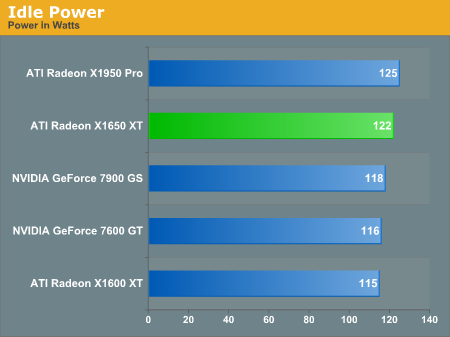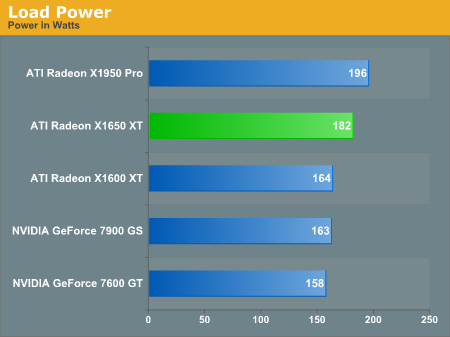Introducing the Radeon X1650 XT: A New Mainstream GPU from ATI
by Josh Venning on October 30, 2006 6:00 AM EST- Posted in
- GPUs
Power
Power consumption is always an important factor when looking at how a graphics card performs, and we did some tests here to determine how the X1650 XT compares to a few other key cards currently on the market. Even though these cards we tested are reference cards, we can still get a general idea of how much power they will use compared to one another. Of course, any card's power consumption has potential to increase or decrease depending on the different tweaks the individual vendors will make to them before shipping them out.

For these tests we start with the total power draw of the system with each of the cards installed while idle (no programs running). We chose these five cards because they include a general range of performance relative to the X1650 XT. We can see here that the X1950 Pro and X1650 XT are a little more power hungry than the rest of the cards at idle.

Next we look at the total power draw of the system while running some stress tests on each of the GPUs. The stress test we use is a few of the demos from 3dMark06, which are particularly graphics intensive. We see by this graph that the X1950 Pro is the most power hungry of these cards, which is to be expected given its level of performance. We also see that the X1650 XT has a more substantial power draw than any of the others, and in particular the 7600 GT, which shows to be the least power hungry of the five. The fact that the 7600 GT consumes less power than the X1650 XT is important, as these two cards are direct performance competitors. But again, keep in mind that these are reference cards and there will be some variation between power levels of the different vendor cards using these chipsets.
One nice thing about the X1650 XT is that it doesn't require an external power connection. This makes it a good choice for those with limited connections on their power supplies. However, the 7600 GT also doesn't need an external power connection, so our data might persuade those who are very concerned about power consumption to look into this card instead of the X1650 XT. 6W more power at idle and 24W more power at load (relative to the 7600 GT) shows that NVIDIA still holds a clear advantage when it comes to power requirements. However, the X1650 XT isn't a very power hungry card, so most users won't need to worry about its consumption. Worst case, 24W extra power use running 24/7 over the course of the year would still only amount to around $20. In the mobile market, however, ATI hardware still looks set to be at a disadvantage, as even a couple watts can be significant when you're looking at battery life.
Power consumption is always an important factor when looking at how a graphics card performs, and we did some tests here to determine how the X1650 XT compares to a few other key cards currently on the market. Even though these cards we tested are reference cards, we can still get a general idea of how much power they will use compared to one another. Of course, any card's power consumption has potential to increase or decrease depending on the different tweaks the individual vendors will make to them before shipping them out.

For these tests we start with the total power draw of the system with each of the cards installed while idle (no programs running). We chose these five cards because they include a general range of performance relative to the X1650 XT. We can see here that the X1950 Pro and X1650 XT are a little more power hungry than the rest of the cards at idle.

Next we look at the total power draw of the system while running some stress tests on each of the GPUs. The stress test we use is a few of the demos from 3dMark06, which are particularly graphics intensive. We see by this graph that the X1950 Pro is the most power hungry of these cards, which is to be expected given its level of performance. We also see that the X1650 XT has a more substantial power draw than any of the others, and in particular the 7600 GT, which shows to be the least power hungry of the five. The fact that the 7600 GT consumes less power than the X1650 XT is important, as these two cards are direct performance competitors. But again, keep in mind that these are reference cards and there will be some variation between power levels of the different vendor cards using these chipsets.
One nice thing about the X1650 XT is that it doesn't require an external power connection. This makes it a good choice for those with limited connections on their power supplies. However, the 7600 GT also doesn't need an external power connection, so our data might persuade those who are very concerned about power consumption to look into this card instead of the X1650 XT. 6W more power at idle and 24W more power at load (relative to the 7600 GT) shows that NVIDIA still holds a clear advantage when it comes to power requirements. However, the X1650 XT isn't a very power hungry card, so most users won't need to worry about its consumption. Worst case, 24W extra power use running 24/7 over the course of the year would still only amount to around $20. In the mobile market, however, ATI hardware still looks set to be at a disadvantage, as even a couple watts can be significant when you're looking at battery life.










33 Comments
View All Comments
guidryp - Thursday, November 2, 2006 - link
They spec like this:1650XT: 8 vertex Pipes, 24 pixel pipes, 8 Raster pipes, 575MHz, Mem 675MHz X 128 bus.
7600GT: 5 vertex Pipes, 12 pixel pipes, 8 Raster pipes 560MHz, Mem 700MHz X 128 bus.
And the ATI card barely holds it's own? I was expecting a walkaway after reading the specs.
coldpower27 - Saturday, November 4, 2006 - link
It should be 24 Pixel Shaders vs 12 Pixel Shaders.while both have 8 ROP's, it is probably the X1650 XT only has 8 TMU while the 7600 GT has 12 as both are half their flagship derivatives. Ignore vertex amounts those tpyically aren't half and don't contribute to much on the most part to performance it seems anyway.
X1900 XTX 48 Pixel Shaders, 16 Rasterization Operators, 650MHZ, Mem 775MHZ x 256 Bit Bus
7900 GTX 24 Pixel Shaders, 16 Rasterization Operators, 650MHZ, Mem 800MHZ x 256 Bit Bus
The X1900 XTX doesn't walkaway from the 7900 GTX on the whole either.
trinibwoy - Wednesday, November 1, 2006 - link
Do you guys do other testing that you comment on that is not represented by the graphs? The numbers show a 1 fps difference, yet you use terms like "significant" and "clearly beats". Maybe some median low fps numbers would help demonstrate what you're saying.soydeedo - Monday, October 30, 2006 - link
hey i know i can make an educated guess as to where the x1650xt would end up on q4 benches compared to nvidia's offerings, but i'm still curious why this game was not included in the testing? with quakewars around the corner i think people are still interested in doom 3 engine performance.johnsonx - Monday, October 30, 2006 - link
I suppose this name is part of ATI's general trend lately. It used to be that the XT moniker meant the same GPU with slightly higher clocks. Now it seems like the XT parts are a separate family. The X1300XT has nothing to do with the other X1300's (rather it's a rebadged X1600Pro), the X1900XT has more pipes than non-XT members of the X1900 family, and now the X1650XT has nothing to do with the rest of the X1600/1650 family.It all makes it a bit hard to choose.
Kougar - Monday, October 30, 2006 - link
On page 10 it is mentioned thatThis is completely going against the bar graphs, specifically the HL Episode One graph. The x1650XT got up and began walking away from the 7600GT without AA, but with AA it tripped and slide into place just behind the 7600GT. At resolutions below 1600by1200 it even began losing by a sizeable margin.
Josh Venning - Monday, October 30, 2006 - link
This paragraph has been tweaked a little bit. In HL2 Episode one the X1650 XT only does better than the 7600 GT at the highest resolution with AA enabled, but in Battlefield 2 it performs a little better over most of the resolutions.Cybercat - Monday, October 30, 2006 - link
How many vertex units does this thing have?JarredWalton - Monday, October 30, 2006 - link
See (updated) table on page 2: it has 8 vertex units, 24 pixel pipes, and 8 ROPs. Basically, lots more power than the X1600 XT. I would guess the pixel pipes are more like R580 pipes (i.e. more shader power, but not necessarily the same as an NVIDIA pixel pipeline in raw power).Cybercat - Monday, October 30, 2006 - link
Alright, cool. I keep a chart with stats of graphics cards, so I'm just making sure I have the vertice throughput correct. Other than the useless X1650 Pro, ATI seems to have a much more competitive mainstream line now. There is now more confusion than ever, though.